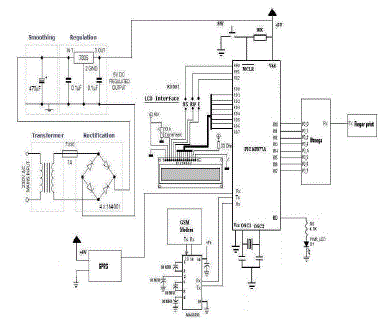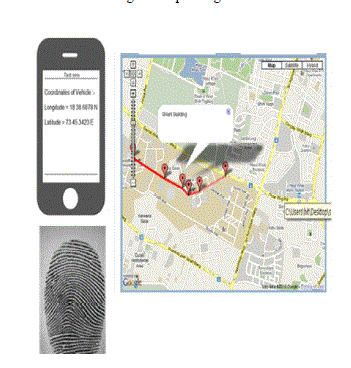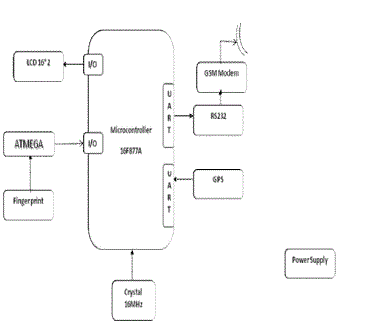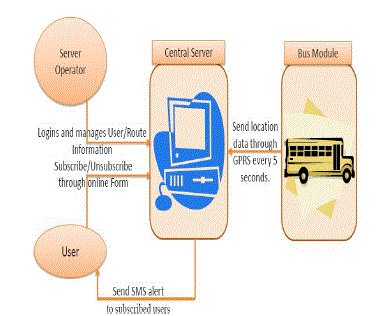ISSN ONLINE(2278-8875) PRINT (2320-3765)
ISSN ONLINE(2278-8875) PRINT (2320-3765)
| Vishnoo Prashanth. R, Mohanagopal.R , Saravana Kumar.M Department of ECE, Sri Sairam Engineering College, Chennai, India |
| Related article at Pubmed, Scholar Google |
Visit for more related articles at International Journal of Advanced Research in Electrical, Electronics and Instrumentation Engineering
Passengers have to wait for a long time, at bus stops for the arrival of the bus, as they are unaware of the whereabouts of the bus. The alerts of the location of the bus are provided to them only at bus stops. Hence a lot of time gets wasted. The proposed system plans for an early warning system to the passengers, two or three hours before the time of boarding, through timely mobile alerts on the route and location of the bus, with the help of a GSM module . First the UID number of the passenger is requested at the time of booking, and his or her fingerprint pattern is stored in the database. The UID number also contains the details of the passengers, which are stored in the database. A GPS module is used for tracing the location of the bus in terms of latitudes and longitudes. The GSM kit sends alerts, to multiple passengers, at an interval of ten minutes each. Once a person boards the bus, his fingerprint is compared with that in the database, and if it matches, then the alerts provided to him are stopped. This ensures that no one else boards the bus, and hence is secure. This is a fully automated system, and requires no interaction with the driver.
INTRODUCTION |
| Embedded systems are one of the prime fields in Electronics and Communication Engineering. This system makes best use of this, to reduce the time wasted by passengers, at bus stops. According to a recent survey conducted, around 350 hrs of time is wasted by 150,000 passengers at bus stops, in the last one year. Waiting time at bus stops, also determines the Quality of Service (Qos). There are unpredictable traffic conditions in cities, due to which the passengers may arrive late at bus stops during the time of boarding. If alerts are provided to them, then, based on the location, they can also change their boarding point accordingly. The UID number of the passenger is requested, at the time of booking, and their fingerprint is read using a fingerprint module. This is then stored in the Atmel ATMEGA controller. The controller is also interfaced with a GPS module, which first determines the location in terms of latitudes and longitudes, and then converts it to text. This text is then sent to the registered passengers, via timely mobile alerts, using a GSM module. The details of the coordinates are stored in a PIC 16F877A controller. Constant frequency of operation is fixed as 16KHZ for the controller, by a crystal oscillator. A RS 232 cable is used to interface the GSM module with the controller. A separate supply of 5V is given, using the power supply unit. Bridge rectifier is also employed, in the circuitry to convert the input AC to DC. |
 |
| (Circuit Diagram) |
WORKING PRINCIPLE |
GPS INTERFACE: |
| The location of the place is found using Google Maps , and the coordinates of the location is found out. These coordinates are converted to text, and sent by the GSM module to the registered passengers. |
 |
FINGERPRINT MODULE |
| UID number is requested from the passenger during the time of booking. It contains the fingerprint of the person. This is read using this module, and is stored in the Atmel ATMEGA controller. The fingerprint is also used to extract the identity of the person i.e. his mobile number from the database, so that alerts can be sent to the authorised person. It is also used to verify whether the person has boarded the bus or not. |
 |
PIC 16F877A CONTROLLER |
 |
| PIC 16F877A controller is employed because it uses high speed RISC processor, with 20Khz clock input, EEPROM technology with retention greater than 40 years. Voltage range is 2.5 to 5V. It also consumes less power. This controller has two UART interfaces, one connected to GPS and the other to GSM. It also has the Atmel ATMEGA connected to the I/O ports, which is connected to fingerprint module. A crystal oscillator is used to set frequency at 16KHZ. The power supply unit rectifies the input and gives it to the controller. |
| Coordinates are displayed in a 16x2 LCD display, which is connected to the output port of the controller. |
OPERATION |
| At the time of booking, UID is registered to the passenger’s travelling details stored in the database.On the day of journey, the databases are transferred to the respective buses.Before 2 hours to the time of departure, the exact position of the buses are located using GPS.These details are sent to the registered passengers using GSM. Once the passengers enter the bus, validity of the registration can be found using fingerprint module. |
 |
ADVANTAGES |
| ïÃâ÷ No ticket verification |
| ïÃâ÷ Can be extended to trains. |
| ïÃâ÷ Highly secure and authentic. |
| ïÃâ÷ Easy route updation. |
References |
|